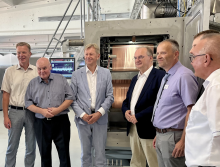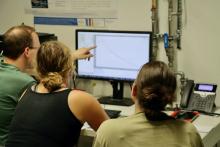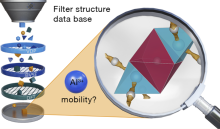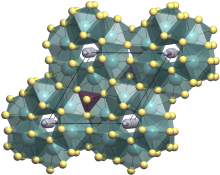Start of the pilot line for the production of resource-efficient current collectors for Li-ion batteries
Together with the Minister President of Saxony-Anhalt, Dr. Reiner Haseloff, the Member of the State Parliament of Saxony-Anhalt, Ulrich Thomas, the Lord Mayor of Quedlinburg, Frank Ruch, the Managing Partner of the GETEC-Group, Dr. Karl Gerhold, and the founder and Managing Director of elfolion GmbH, Dr. Manfred Danziger, the new pilot plant of elfolion GmbH for the production of grid-based current collectors for lithium-ion batteries was successfully launched on 14 August 2024. Production was started at the push of a button by the Prime Minister.
The current collectors developed by elfolion GmbH represent a new class of resource-efficient, three-dimensional current collectors in the form of a woven grid. They are based on ultra-light multifilament glass filaments that are woven into a grid and surrounded by a thin metal layer in a roll-to-roll process using physical vapour deposition. This saves > 90% of the copper and aluminium metals required compared to commercially used metal foils and reduces the mass of the current collectors by > 80%. At the same time, the gravimetric capacity of anodes with graphite active material and cathodes with LiCoO2 active material increases by > 61% and > 16% respectively, while full cells are characterised by an increase of > 32%. This means that the specific energy can be improved by 11%. Button cells achieve more than 300 cycles with a capacity retention of 70% and a Coulomb efficiency of > 99.7%. Initial results of this technology patented by elfolion GmbH were submitted for publication in 2024.
The first proof of functionality in so-called half cells was provided in 2018 at the Institute of Experimental Physics at TU Bergakademie Freiberg by Wolfram Münchgesang and Tilmann Leisegang. Since then, the current collectors have been further developed in joint R&D projects with other partners, in particular with the Institute of Textile Machinery and High Performance Textile Materials (ITM) at the Technische Universität Dresden and the Chair of Production Engineering of Electromobility Components (PEM) at RWTH Aachen University in cooperation projects funded by the Federal Ministry of Economics and Climate Protection (BMWK) of the Federal Republic of Germany (LiIonSK: ZF4751502JO9, revoLect: 03ETE041H, 3D-Si electrode: 16BZF310B).
With the ceremonial commissioning of the pilot line on 14 August 2024, an important step towards the commercialisation of the technology has now been established. It will enable the production of significantly larger quantities of current collectors, which will be supplied to the first customers in research and industry. At the same time, this represents a significant step towards upscaling.
Further press releases can be found here, for example: GETEC, Tagesschau, MDR, Volksstimme 1, Volksstimme 2, Mitteldeutsche Zeitung
Tilmann Leisegang organizes BioNanoTec Week 2024
As part of the BioNanoTec Week students can find out about the Applied Natural Sciences degree program, get to know university life and the work of scientists, and get inspiration for their career choices. The BioNanoTec Week is organized by Tilmann Leisegang with the support of the Dean of Studies of the degree program "Applied Natural Sciences" and her deputy, the Department of Marketing and Student Advisory Service at TUBAF and all participating scientists involved. Further details on the 8. BioNanoTec Week can be found here.
Participation in the Innovation Day for SMEs organised by the Federal Ministry of Economics and Climate Protection (BMWK)
On 13.06.2024, Tilmann Leisegang, together with Dr. Dominik Nuss from the Institute of Textile Machinery and High Performance Materials Technology at TU Dresden and Dr. Jens Harhausen from elfolion GmbH, presented the results of the ZIM-funded project "Development of film-like, resource-efficient, fabric-based current collectors for electrodes for high-energy and -power density lithium-ion cells made of ultra-fine glass multifilament yarns and metal wires (ZF4751502JO9)" as an exhibitor at the Innovation Day for SMEs organised by the Federal Ministry of Economics and Climate Protection (BMWK). He accepted the BMWK's invitation due to the "impressive results of the project" and thus represented the Institute of Experimental Physics at TU Bergakademie Freiberg, Energy Materials working group. elfolion GmbH presented the development of the innovation as part of the "stage talk".
The Innovation Day for SMEs, organised by the BMWK in Berlin Pankow, stands for innovative projects, high-performance companies and bright minds. Under the motto This is how the future works! - Digital. Transformative. Resilient., visitors could feel the creative energy with which SMEs are tackling the issues of the future and driving technological change. At the open-air event, SMEs and the research institutions cooperating with them had the opportunity to present their pioneering developments, which have been realised with the support of the BMWK's open-topic innovation funding. The Federal Minister of Economics and Climate Protection, Dr Robert Habeck, was also present.
Selection of article on aluminum-ion conduction materials for ACS "Virtual Collection"
04/2024: Selection of the article "Combined Theoretical Approach for Identifying Battery Materials: Al3+ Mobility in Oxides" for the Virtual Collection "Computational Chemistry for Materials Discovery" of the American Chemical Society.
High-throughput screening of inorganic crystal structures finds new class of ionic conductors with La3CuSiS7 structure
Together with the SCTMS, a high-throughput screening of the Inorganic Crystal Strcuture Database (ICSD) for new promising Ca2+-, Mg2+-, Zn2+- und Al3+-ion-conducting ternary and quaternary sulfides, selenides and tellurides (∼1500 compounds) was performed. A geometric topological approach based on Voronoi partitioning was initially applied and yielded 104 compounds that were unknown as ion conductors with possible cation conduction. All compounds were subjected to bond valence site energy analysis to determine the migration energy. In addition, the logarithmic dependencies of migration energy on the geometric parameters of the migration pathways were determined. As a result, 16 out of 104 structures were filtered out as promising ionic conductors. Finally, density functional theory calculations revealed 11 most promising compounds with migration energies < 1.0 eV. Among them is a new class of ionic conductors with the structure La3CuSiS7, for which ab initio molecular dynamics calculations were performed. These resulted in diffusion coefficients of ∼10-7 cm2 s-1 and ionic conductivities of ∼10-2 S cm-1 at 300 K. The results were added to the Battery Materials Database.
A. A. Kabanov, Y. A. Morkhova, V. Osipov, M. Rothenberger, T. Leisegang, Vladislav A. Blatov
A Novel Class of Multivalent Ionic Conductors of the La3CuSiS7 Structure Type: the Results of Stepwise ICSD Screening.
Physical Chemistry Chemical Physics 26, 2622 (2024).
Archive "News"
- Ad hoc colloquium "From atoms to nets"
- Erfolgreicher Start der BioNanoTec-Woche 2022
- Tilmann Leisegang speaks about battery research at the CCS-2022
- Master thesis defense of Yen-Ming Li – demonstrating a novel class of current collectors
- Manuel Rothenberger successfully prepared for the next level
- Tilmann Leisegang elected to the committee of the Lieselotte Templeton Prize of the DGK
- Tilmann Leisegang participated in INDOGFOE 2021
- Tilmann Leisegang visited the SCTMS at SSTU
- When crystals throw lightning: Model helps to understand pyroelectric processes (German press release)
- Kick-off meeting for a ZIM project on the development of novel current collectors
- Tilmann Leisegang was on research visit to the SCTMS
- 30th Seminar of the Working Group Electrochemistry in Saxony
- Tilmann Leisegang gave a plenary lecture at the Saxon Academy of Sciences and Humanities in Leipzig
- Falk Meutzner successfully defended his doctoral thesis
- Review article on aluminium-ion battery belongs to the “Most Viewedâ€
- Tilmann Leisegang for a research visit at University of Milan
- Research visit and lecture of Professor Siegbert Schmid from the University of Sydney
- Participation at the 21st Mendeleev Congress in St. Petersburg




